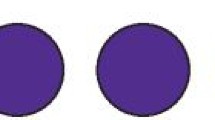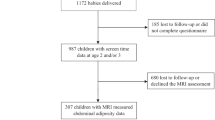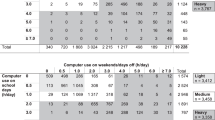Abstract
Background/Objectives:
This longitudinal study describes the relationship between young children’s screen time, dietary habits and anthropometric measures. The hypothesis was that television viewing and other screen activities at baseline result in increased consumption of sugar-sweetened beverages (SSB) and increased BMI, BMI z-score and waist to height ratio (WHtR) two years later. A second hypothesis was that SSB consumption mediates the association between the screen activities and changes in the anthropometric measures.
Subjects/Methods:
The study is a part of the prospective cohort study IDEFICS (“Identification and prevention of dietary and lifestyle-induced health effects in children and infants”), investigating diet, lifestyle and social determinants of obesity in 2 to 9-year-olds in eight European countries (baseline n=16 225, two-year follow-up; n=11 038). Anthropometry was objectively measured, and behaviours were parent-reported.
Results:
The main hypothesis was supported, but the second hypothesis was not confirmed. The odds ratio of being in the highest quintile of % change in WHtR was 1.26 (95% CI: 1.17–1.36) and in BMI 1.22 (95% CI: 1.13–1.31), for each hour per day watching television. The odds ratio of having increased SSB consumption was 1.19 (95% CI: 1.09–1.29) for each hour per day watching TV. The associations for total screen time were slightly weaker.
Conclusions:
The results indicate substantial effects of TV viewing and other screen activities for young children, both on their consumption of sugary drinks and on an increase in BMI and central obesity. Our findings suggest that television viewing seems to have a stronger effect on food habits and anthropometry than other screen activities in this age group.
This is a preview of subscription content, access via your institution
Access options
Subscribe to this journal
Receive 12 print issues and online access
$259.00 per year
only $21.58 per issue
Buy this article
- Purchase on Springer Link
- Instant access to full article PDF
Prices may be subject to local taxes which are calculated during checkout



Similar content being viewed by others
References
Reilly JJ, Kelly J . Long-term impact of overweight and obesity in childhood and adolescence on morbidity and premature mortality in adulthood: systematic review. Int J Obesity 2011; 35: 891–898.
te Velde SJ, van Nassau F, Uijtdewilligen L, van Stralen MM, Cardon G, De Craemer M et al. Energy balance-related behaviours associated with overweight and obesity in preschool children: a systematic review of prospective studies. Obesity Rev 2012; 13: 56–74.
De Craemer M, De Decker E, De Bourdeaudhuij I, Vereecken C, Deforche B, Manios Y et al. Correlates of energy balance-related behaviours in preschool children: a systematic review. Obesity Rev 2012; 13: 13–28.
van Stralen MM, te Velde SJ, van Nassau F, Brug J, Grammatikaki E, Maes L et al. Weight status of European preschool children and associations with family demographics and energy balance-related behaviours: a pooled analysis of six European studies. Obesity Rev 2012; 13: 29–41.
Swinburn B, Shelly A . Effects of TV time and other sedentary pursuits. Int J Obesity 2008; 32: S132–S136.
Cleland VJ, Schmidt MD, Dwyer T, Venn AJ . Television viewing and abdominal obesity in young adults: is the association mediated by food and beverage consumption during viewing time or reduced leisure-time physical activity? Am J Clin Nutr 2008; 87: 1148–1155.
Wiecha JL, Peterson KE, Ludwig DS, Kim J, Sobol A, Gortmaker SL . When children eat what they watch. Impact of television viewing on dietary intake in youth. Arch Pediatr Adolesc Med 2006; 160: 436–442.
Santaliestra-Pasías AM, Mouratidou T, Verbestel V, Huybrechts I, Gottrand F, Le Donne C et al. Food consumption and screen-based sedentary behaviors in european adolescents. Arch Pediatr Adolesc Med 2012; 166: 1010–1020.
Marshall SJ, Biddle SJH, Gorely T, Cameron N, Murdey I . Relationships between media use, body fatness and physical activity in children and youth: a meta-analysis. Int J Obesity 2004; 28: 1238–1246.
Johnson BA, Kremer PJ, Swinburn BA, de Silva-Sanigorski AM . Multilevel analysis of the Be Active Eat Well intervention: environmental and behavioural influences on reductions in child obesity risk. Int J Obes 2012; 36: 901–907.
Moreno LA, Rodríguez G . Dietary risk factors for development of childhood obesity. Curr Opin Clin Nutr Metab Care 2007; 10: 336–341.
Ludwig DS, Peterson KE, Gortmaker SL . Relation between consumption of sugar-sweetened drinks and childhood obesity: a prospective, observational analysis. Lancet 2001; 357: 505–508.
Kelly B, Halford JCG, Boyland EJ, Chapman K, Bautista-Castano I, Berg C et al. Television food advertising to children: a global perspective. Am J Public Health 2010; 100: 1730–1736.
Duffey K, Huybrechts I, Mouratidou T, Libuda L, Kersting M, De Vriendt T et al. Beverage consumption among European adolescents in the HELENA study. Eur J Clin Nutr 2012; 66: 244–252.
Han JC, Lawlor DA, Kimm SYS . Childhood obesity. Lancet 2010; 375: 1737–1748.
Lissner L, Lanfer A, Gwozdz W, Olafsdottir S, Eiben G, Moreno LA et al. Television habits in relation to overweight, diet and taste preferences in European children: the IDEFICS study. Eur J Epidemiol 2012; 27: 705–715.
Ahrens W, Bammann K, Siani A, Buchecker K, De Henauw S, Iacoviello L et al. The IDEFICS cohort: design, characteristics and participation in the baseline survey. Int J Obesity 2011; 35: S3–S15.
De Henauw S, Verbestel V, Mårild S, Barba G, Bammann K, Eiben G et al. The IDEFICS community-oriented intervention programme: a new model for childhood obesity prevention in Europe? Int J Obesity 2011; 35: S16–S23.
Verbestel V, De Henauw S, Maes L, Haerens L, Mårild S, Eiben G et al. Using the intervention mapping protocol to develop a community-based intervention for the prevention of childhood obesity in a multi-centre European project: the IDEFICS intervention. Int J Behav Nutr Phys Act 2011; 8: 1–15.
Cole TJ, Bellizzi MC, Flegal KM, Dietz WH . Establishing a standard definition for child overweight and obesity worldwide: international survey. BMJ 2000; 320: 1–6.
Lanfer A, Hebestreit A, Ahrens W, Krogh V, Sieri S, Lissner L et al. Reproducibility of food consumption frequencies derived from the Children's Eating Habits Questionnaire used in the IDEFICS study. Int J Obesity 2011; 35: S61–S68.
Bel-Serrat S, Mouratidou T, Pala V, Huybrechts I, Börnhorst C, Fernández-Alvira JM et al. Relative validity of the Children's Eating Habits Questionnaire – food frequency section among young European children: the IDEFICS Study. Public Health Nutr 2013, (FirstView) 1–11.
UNESCO International Standard Classification for Education ISCED 1997. UNESCO Institute for Statistics: Montreal, 2006.
Evenson KR, Catellier DJ, Gill K, Ondrak KS, McMurray RG . Calibration of two objective measures of physical activity for children. J Sports Sci 2008; 26: 1557–1565.
Cole TJ, Freeman JV, Preece MA . British 1990 growth reference centiles for weight, height, body mass index and head circumference fitted by maximum penalized likelihood. Stat Med 1998; 17: 407–429.
Yan W, Bingxian H, Hua Y, Jianghong D, Jun C, Dongliang G et al. Waist-to-height ratio is an accurate and easier index for evaluating obesity in children and adolescents. Obesity 2007; 15: 748–752.
McCarthy HD, Ashwell M . A study of central fatness using waist-to-height ratios in UK children and adolescents over two decades supports the simple message - 'keep your waist circumference to less than half your height'. Int J Obesity 2006; 30: 988–992.
Nambiar S, Truby H, Hughes I, Davies PSW . Utility of the waist-to-height ratio as an instrument to measure parental perception of body weight in children and its use in a population-based survey of children. Public Health Nutrition 2013; 16: 274–280.
Cairns G, Angus K, Hastings G . The Extent, Nature and Effects of Food Promotion to Children: A Review of the Evidence to December 2008. World Health Organization: Geneva, 2009.
World Health Organization. Set Of Recommendations On The Marketing of Foods and Non-Alcoholic Beverages to Children. In., Geneva: World Health Organization Geneva, 2010.
Olafsdottir S, Eiben G, Prell H, Hense S, Lissner L, Mårild S et al. Young children's screen habits are associated with consumption of sweetened beverages independently of parental norms. Int J Public Health 2013, Published online 27 April 2013.
Rey-López JP, Vicente-Rodríguez G, Biosca M, Moreno LA . Sedentary behaviour and obesity development in children and adolescents. Nutr Metab Cardiovasc Dis 2008; 18: 242–251.
Stamatakis E, Coombs N, Jago R, Gama A, Mourao I, Nogueira H et al. Associations between indicators of screen time and adiposity indices in Portuguese children. Prev Med 2013; 56: 299–303.
Maurer J, Taren DL, Teixeira PJ, Thomson CA, Lohman TG, Going SB et al. The psychosocial and behavioral characteristics related to energy misreporting. Nutr Rev 2006; 64: 53–66.
Acknowledgements
This study was conducted as part of the IDEFICS study (http://www.idefics.eu). We gratefully acknowledge the financial support of the European Community within the Sixth RTD Framework Programme Contract No. 016181 and the grant support from EU for the IDEFICS study. We are grateful for the support provided by school boards, headmasters and communities. We thank the IDEFICS children and their parents for participating in this extensive examination.
Author information
Authors and Affiliations
Consortia
Corresponding author
Ethics declarations
Competing interests
The authors declare no conflict of interest.
Additional information
Supplementary Information accompanies this paper on European Journal of Clinical Nutrition website
Supplementary information
Rights and permissions
About this article
Cite this article
Olafsdottir, S., Berg, C., Eiben, G. et al. Young children’s screen activities, sweet drink consumption and anthropometry: results from a prospective European study. Eur J Clin Nutr 68, 223–228 (2014). https://doi.org/10.1038/ejcn.2013.234
Received:
Revised:
Accepted:
Published:
Issue Date:
DOI: https://doi.org/10.1038/ejcn.2013.234
Keywords
This article is cited by
-
Wirkungen digitaler Medien auf die Gesundheit von Kindern und Jugendlichen mit Schwerpunkt auf dem Verzehr ungesunder Lebensmittel
Bundesgesundheitsblatt - Gesundheitsforschung - Gesundheitsschutz (2024)
-
Free sugar intake and associated factors among Sri Lankan preschool children
BMC Nutrition (2022)
-
Effectiveness and moderators of a multicomponent school-based intervention on screen time devices: the Movimente cluster-randomized controlled trial
BMC Public Health (2021)
-
Polygenic risk for obesity and its interaction with lifestyle and sociodemographic factors in European children and adolescents
International Journal of Obesity (2021)
-
Extracurricular Sports Participation and Sedentary Behavior in Association with Dietary Habits and Obesity Risk in Children and Adolescents and the Role of Family Structure: a Literature Review
Current Nutrition Reports (2021)



